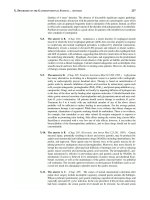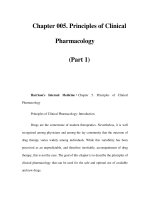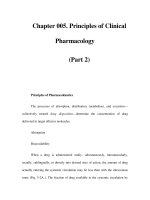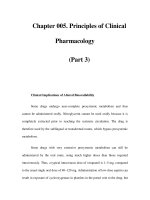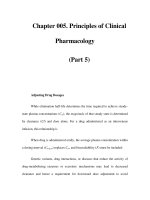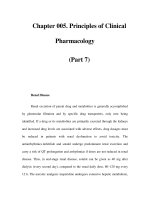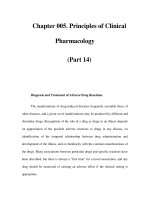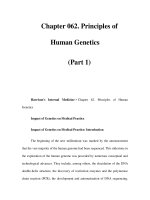Chapter 062. Principles of Human Genetics (Part 7) potx
Bạn đang xem bản rút gọn của tài liệu. Xem và tải ngay bản đầy đủ của tài liệu tại đây (39.74 KB, 5 trang )
Chapter 062. Principles of
Human Genetics
(Part 7)
Transcriptional Activation and Repression
Every gene is controlled uniquely, whether in its spatial or temporal pattern
of expression or in its response to extracellular signals. It is estimated that
transcription factors account for ~30% of expressed genes. A growing number of
identified genetic diseases involve transcription factors (Table 62-2). The MODY
(maturity-onset diabetes of the young) disorders are representative of this group of
diseases; mutations in several different islet cell–specific transcription factors
cause various forms of MODY (Chap. 338).
Table 62-2 Selected Examples of Diseases Caused by Mutations and
Rearrangements in Transcription Factor Classes
Transcription
Factor Class
Example Associated Disorder
Complete or partial androgen
insensitivity (recessive missense
mutations)
Nuclear
receptors
Androgen
receptor
Spinobulbar muscular atrophy
(CAG repeat expansion)
Zinc finger
proteins
WT1
WAGR syndrome: Wilm's
tumor, aniridia, genit
ourinary
malformations, mental retardation
Basic helix-loop-
helix
MITF
Waardenburg syndrome type
2A
Homeobox IPF1
Maturity onset of diabetes
mellitus type 4 (heterozygous
mutation/haploinsufficiency)
Pancreatic agenesis
(homozygous mutation)
Leucine zipper Retina
leucine zipper
(NRL)
Autosomal dominant retinitis
pigmentosa
High mobility
group (HMG) proteins
SRY Sex-reversal
Forkhead HNF4α,
HNF1α, HNF1β
Maturity-
onset of diabetes
mellitus types 1, 3, 5
Paired box PAX3
Waardenburg syndrome types 1
and 3
T-box TBX5 Holt-
Oram syndrome (thumb
anomalies, atrial or ventricular septum
defects, phocomelia)
Cell cycle
control proteins
P53 Li-
Fraumeni syndrome, other
cancers
Coactivators CREB
binding protein
(CBP)
Rubinstein-Taybi syndrome
General
transcription factors
TATA-
binding protein
(TBP)
Spinocerebellar ataxia 17
(CAG expansion)
Von Hippel–Lindau
syndrome
(renal cell carcinoma,
pheochromocytoma, pancreatic
tumors, hemangioblastomas)
Transcription
elongation factor
VHL
Autosomal dominant
inheritance, somatic inactivation of
second allele (Knudson two-
hit
model)
Runt CBFA2
Familial thrombocytopenia
with propensity to acute myelogenous
leukemia
Chimeric
proteins due to
translocations
PML—
RAR
Acute promyelocytic
leukemiat(15;17)(q22;q11.2-q12)
translocation
Note: Selected abbreviations include: SRY, sex determining region Y;
HNF, hepatocyte nuclear factor; CREB (cAMP responsive element binding)
binding protein; VHL, Von Hippel–Lindau; PML, promyelocytic leukemia; RAR,
retinoic acid receptor.
